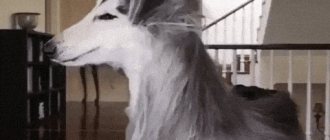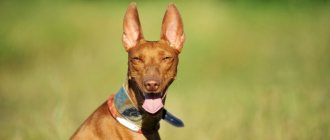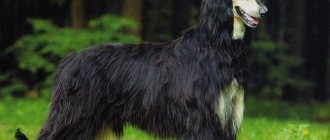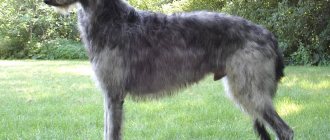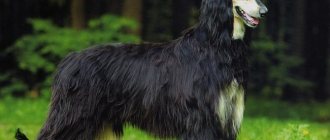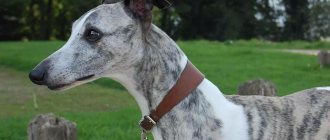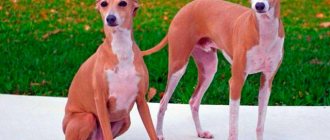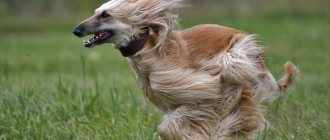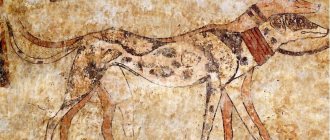The pride of Russian cynology, russian hortaya greyhound, attracts with its outstanding hunting and running skills and appearance. This dog is used to hunt hare, fox and saiga; she is able to cope even with a wolf. Hortaya is the recognized “master of catching” among all greyhounds. There are legends about her endurance: a young greyhound chased a gazelle for 6 kilometers and “took” it. Dirt does not stick to her smooth short fur and thorns do not stick. These greyhounds feel great in the hot regions of our country. The breed standard was first described in the early 50s of the 20th century.
Origin
The Hortaya is an indigenous dog breed, the smooth-haired greyhound was once common in southwestern Russia. The formation of the dog's appearance and working qualities took place in the conditions of hunting a fast animal in the steppe. The long hunting season placed increased demands on the animal's endurance; the fast steppe animals could be overtaken by a dog with good speed characteristics.
The basis for the formation of the modern appearance of the Horta Greyhound was the Polish Harts, Greyhounds, Asian Greyhounds and South Russian Greyhounds. As a result of changes in hunting rules in the mid-20th century, the number of Horty in Russia began to decline rapidly. The best representatives of the breed were taken to Poland.
With the advent of the 21st century, the situation has changed somewhat; Moscow and Stavropol cynologists have restored the breed. Currently, chorts are being trained in nurseries in Moscow, St. Petersburg, Rostov region, Volgograd region, and Stavropol region. There are nurseries in Ukraine and Belarus.
Interesting Facts
The Hortaya Greyhound is a vivid example of the fact that in the history of any breed there is a lot of interesting things:
- In the 17th century, the word “hort” was used to describe any greyhound-like dog, regardless of its breed. For the first time, the term “hortaya” was used in relation to the smooth-haired greyhound when describing animals in the kennel that belonged to Anna Ioannovna.
- In 2002, the National Club of Breed Lovers was created under the Russian Canine Federation, which is engaged in stabilizing and popularizing dogs, as well as seeking their recognition at the international level.
- Thanks to its light frame and streamlined silhouette, the Hortai Greyhound reaches speeds of up to 90 km/h and catches up with the saiga.
Exterior
The dog ( pictured ) with an elongated body is distinguished by strong bones and lean muscles. With a height of 61 - 75 cm, she weighs only 25 to 35 kg.
The head is elongated, dry, slightly compressed from the sides. Brown large eyes are set obliquely. The ears are thin and small. The neck is elongated and muscular.
The back, wide and muscular, forms a small arch with the lower back. The belly is tucked in. The long saber-shaped tail is slightly tucked when at rest. The Horta's paws are strong and strong, the nails and paw pads are highly durable - they do not break or wear out on hard, dry soil.
The short, dense coat protects the dog well from cold winds and does not create discomfort in hot weather. A slight undercoat is present only in winter. On the hips and nape the hair is longer and thinner. The color can be solid or piebald, the following colors are acceptable:
- White;
- Grey;
- Black;
- Murugiya;
- brindle;
- Sexual.
There may be a black mask on the face.
How to choose a puppy
First of all, decide for what purpose you want to purchase a puppy of this interesting, but not simple breed: for work, breeding, for exhibitions or just for fun. The cost of a puppy directly depends on this - the average cost of a puppy from a planned mating is three hundred dollars. There are many mongrels for sale - you can buy them cheaper. But there are also “copies” that cost much more, even up to three or four thousand dollars - they have great pedigree or useful value.
A good greyhound puppy can only be purchased from a reputable stable.
If we are not talking about working qualities, but only about the appearance of the child, there are several points that you should pay special attention to:
- on the head - the Hortai breed should have dark eyes (in a puppy they can be dark gray, but not blue), and the muzzle and skull should be the same length;
- by coat - thick and springy coat should be close to the body, even a puppy’s coat should not have a lot of undercoat
- Body shape - should be close to square, not elongated or too short;
- Paws - the limbs are dry, but very strong, the growth areas are well defined;
Character
The character of the greyhound was formed in harsh conditions. It has such features as:
- Endurance;
- Courage;
- Persistence;
- Good visual response;
- Intelligence.
The large, thin dog has a calm character and behaves quietly in the house. The working qualities of a dog ( field leisure ) - viciousness, acceleration, power, agility, tirelessness and others, are partly innate and are improved during training.
Relationships with other pets
A dog will get along well with other pets if introduced to them as a puppy.
Relationships with children
A dog that makes friends with a child will look after him and protect him.
Azawakh
The smooth-haired greyhound comes from Mali (Africa). Initially it was used as a hunter “with sight”, and also as a companion of rich nomads. The height at the withers is 64-74 cm for males and 60-70 cm for females. Body weight depends on gender and ranges from 15-25 kg.
The dog has a refined physique, with muscles and bones clearly visible under the skin. The body of the Azawakh is rectangular, supported by long limbs. The dogs' heads are elongated, dry, and rather narrow. Characteristic features include thin drooping ears and a long tail with a white tassel. The color is always red with markings. The nature of the dogs is reserved, the Azawakh is distrustful of strangers and affectionate with loved ones.
Content
You can keep a dog in an urban environment. Outside the city, Horts are placed in insulated enclosures or sheds. The dog needs frequent walks and lots of physical activity.
What to feed
A large animal, the Hortai Greyhound, should receive adequate nutrition; you can use ready-made industrial feed. You should not feed it before training, hunting or active walks, as this can cause volvulus in the dog.
Care
Wool does not require special care. It is enough to comb it occasionally with a brush.
Feeding rules
Short greyhounds are genetically endowed with a high metabolic rate, which ensures energy supply to all organs and, in particular, muscle tissue. Therefore, food should contain foods with high calorie content - carbohydrates in the form of cereals, flour products (bread). Porridges are well boiled, but coarse ones, such as oatmeal, are given only crushed.
Young and adult dogs need raw meat and canned meat for plastic processes. Both carcasses of small animals - gophers, for example, as well as offal and animal fat are suitable for feeding. Greyhounds do not digest pork well, so the amount should be limited or completely eliminated.
The diet should be supplemented with vegetables - potatoes, carrots, beets, cabbage. It is advisable to alternate vegetables. Greens are introduced into the food - beet and carrot tops, young scalded nettles. The food should be liquid - porridge is poured with milk, buttermilk, whey. Dogs are also given other dairy products - cottage cheese, hard cheese.
Strong bones and healthy teeth are formed with sufficient amounts of phosphorus and calcium. Vitamins, micro- and macroelements should be included in the greyhound’s diet not only with food (bone meal, fish, bones), but also in the form of mineral and vitamin supplements, rock salt. Food should be warm and fresh. The dog should always have fresh water.
If the owner does not have the opportunity to cook for his pet himself, he can feed him ready-made diets. The best option is premium and super-premium category food. They have a balanced composition and do not require additional feeding with vitamins and minerals. The only thing the owner needs is to provide the pet with constant access to water.
FINNISH SPITZ (FIN. SUOMENPYSTYKORVA, ENG. FINNISH SPITZ) HUNTING BREED OF DOG
FILA BRAZILEIRO (BRAZILIAN FILA, BRAZILIAN MASTIF, ENGLISH FILA BRASILEIRO)
THE PHARAOH HOG IS LEAN, MUSCULAR, GRACEFUL, FAST AND AGILITY
FRENCH BULLDOG WITH A FRIENDLY CHARACTER
Features of training
You need to raise a pet from an early age. A dog raised in a calm environment shows good results in hunting. She understands her master perfectly.
You definitely need to take an obedience course. A large, strong dog has a developed instinct of dominance; If you don’t immediately show her who’s boss, there may be problems in the future.
The dog's working qualities ( field leisure ) are assessed during field trials. Despite the greyhound's inherent hunting instinct, it must undergo a special training course if it is to be used as a hunting dog. During training, her “passion” for hunting will awaken and she will “pump up her muscles.”
Despite the attractive “noble” appearance and calm character, the Russian Hortai Greyhound is not very suitable for the role of a pet; it is exclusively a hunting and commercial dog.
Caring for the Horta Greyhound
For a working dog, it is more acceptable not to live in an apartment, but in a yard, since in this case the dog gets used to temperature changes and tolerates them more easily. But short hair with a poor undercoat is not able to protect animals from severe frosts, so they live and hunt mainly in the southern steppes.
Feeding
The thinness of this dog, which immediately catches the eye, is a natural condition for the breed: the Horta’s ribs should be “transparent” and the ribs should stick out - the last point is even officially stated in the standard.
The slenderness of the Horta may seem unnecessary to some
Such almost model-like slimness does not indicate malnutrition, but a rapid metabolism, which is generally characteristic of greyhounds. Shorthairs love to eat, food for them should be plentiful and high-calorie - but here it is extremely important to maintain a balance: give the dog the necessary energy nutrition and at the same time not harm its health.
Most owners prefer a natural diet for smooth-haired greyhounds, with the help of which they can independently regulate the pet’s nutrition depending on the stress they receive and the time of year - in winter the energy of the menu should increase significantly. It is advisable that the food be rich in carbohydrates, but easily digestible: if you give your dog porridge, try to boil it as much as possible and dilute it to a semi-liquid state - but not with broth, but with low-fat fermented milk, for example, whey.
The introduction of vegetables and root vegetables (except potatoes) into the diet is welcome - they need to be alternated and it is better to give them raw, chopped. But the basis of nutrition is, of course, high-quality protein - raw meat (not pork). Experienced hunters recommend feeding dogs whole small game, including hair or feathers, once a week.
The following foods are taboo for short greyhounds:
- any food from the human table;
- everything fatty, spicy, smoked or sweet;
- legumes and citrus fruits;
- fresh baked goods.
Those who prefer high-quality ready-made food can be recommended to pay attention to the following products intended for feeding active dogs:
- Brit Premium Sport;
- K9 Selection HI-Performance;
- Arden Grange Adult Dog Prestige;
- ACANA Sport & Agility;
- Happy Dog Supreme Canada.
Hygiene
The Horta Greyhound's fur (as hunters usually call the fur of working dogs) is unique in its structure. Dirt does not stick to it at all, cereal seeds and thorns do not cling. Needless to say, there are never tangles on such wool - it requires minimal care. If the dog lives indoors, then after a walk you need to wash its paws and “walk” along its fur with a silicone mitt to remove dirt and dead hair.
Hortys have wool that does not get dirty, does not tangle, and “repels” thorns
The outer hair of this breed has the property of self-cleaning, and frequent bathing is definitely not required. Hortys don’t mind swimming in a natural body of water at all, and they need a full bath once every three months, or even less often - usually they bring beauty only before exhibitions.
Otherwise, your pet will need the most common hygiene procedures - regular examination and cleaning of eyes, ears and teeth, trimming of claws, if necessary.
Walk
Those rare owners who get a Horta not for hunting, but for pleasure, must be prepared for long walks and jogs with the dog - it is vital for it to cover at least ten kilometers every day in the rhythm of at least a fast trot. Even the most spacious farmstead cannot replace such thorough walks with the owner in any weather.
Outdoor games are a necessary warm-up before work
Try to find time for active games with your dog: chase him after a Frisbee, a ball, a stick - this will help maintain not only your pet’s tone, but also his motivation to work.
Training
The Russian Hortai successfully participates in competitions that require special training. This is an intelligent, highly trainable dog that is willing to train and shows excellent results. Hortys, compared to other breeds, mature very early - already at the age of eleven months they can work independently, for example, with a hare.
Greyhounds are created for hunting, not for guarding - they should not be retrained
Socialization and primary education of puppies can begin when they are three months old. At the same time, it is very important to take care of the dog’s forming bones and its joints - to dose out physical activity. Those who like to chase a greyhound after a bicycle should not start such activities earlier than nine to ten months.
After completing a general training course for six-month-old puppies, it is quite possible to begin teaching working skills. Their protective instincts are poorly developed, but with some individuals it is possible to achieve success in this direction.
Mating
Now let's talk about mating an Arabian greyhound. The animal’s body is most prepared for bearing offspring and giving birth at the age of 2 years. You shouldn't take your dog before. A good time for conception begins on the 11th day of estrus, when spotting appears. This period lasts no more than 6 days. Before breeding a bitch, you need to walk her, but you don’t need to feed her. A bitch is brought to a dog for mating
This is an important condition for successful mating. First, the animals are introduced and given time to sniff.
The dogs can even run and play during the process. You should not interfere with animals in this matter. If the bitch is ready to conceive, mating will definitely occur. During this process, the dogs stand in the castle for 20 minutes to 1 hour, and they cannot be split. After a day, the mating should be repeated.
Abilities and training
Initially, the German Hound breed was conceived as exclusively a breed for hunting. However, the representatives’ abilities were not limited to hunting skills inherited from their ancestors. The German hound easily learns new commands, is capable of guarding the territory, and protecting the owner and his family members. The dog's intelligence is rated above average.
This is a rather passionate, hardy, courageous dog that shows good endurance and stability in difficult circumstances. It is these qualities that make the German hound one of the best in the hunting business. These are excellent companions who love and are ready to serve their master faithfully.
With adequate and competent training, they show good abilities in hunting both large and small game. Works on dry and blood trails. Fast, strong-willed and purposeful. Orients himself well in space, finds his way in unfamiliar places.
With good maintenance and appropriate care, life expectancy is ten to twelve years.
Health
Russian greyhounds are fairly healthy dogs, but they have a predisposition to volvulus. Feeding your pet small portions several times a day helps prevent the occurrence of a life-threatening condition. Having eaten a lot of food at once, the dog will develop excessive gas, which can cause bloat. After eating, your pet should not be allowed to move actively before an hour later. There is also a risk of eye pathologies, primarily cataracts.
An automatic dog feeder will help you in the correct dosage of food, which will also dispense food strictly at the programmed time. It also has a whole host of useful options. It would be better to add an automatic waterer for dogs, which will provide your pet with clean, filtered water around the clock.
Many greyhounds are overly sensitive to anesthetics, which is why medications should be selected with extreme caution. An allergic reaction to means for getting rid of parasites, both body and worms, may also occur.
It is worth asking the breeder what medications he uses for his dogs.
For preventive purposes, it is necessary to show the dog to a veterinarian once every 6 months. You should contact him immediately if your pet shows signs of deterioration in health or neoplasms. Vaccination is carried out regularly: for puppies twice, and for adult pets once a year.
Long awaited litter of puppies
Australian Kelpie - Cattle Dog
Description of the breed
The Australian Kelpie has a fairly compact body. The height at the withers is on average 45 cm, and the weight usually does not exceed 20 kg. The Australian Kelpie has a special appearance: a long body, a powerful, wide chest, a strong croup, short but powerful legs. The head is proportional to the size of the body; the skull is slightly rounded and wide between the ears. Pronounced transition from forehead to muzzle. The cheeks are not rough, not protruding, but roundly leading to the muzzle, which is clearly “chiseled”. The muzzle is slightly shorter than the length of the skull. The lips are dense and “clean”, not saggy. The color of the nose matches the coat. The overall appearance is reminiscent of a fox-like expression, softened by almond-shaped eyes.
The Australian Kelpie's ears are erect and pointed; the skin is thin but strong at the base, the ears are set wide apart and tilted forward, with slightly curved outer edges, of medium size. The inside of the ear has quite thick fur.
The Australian Kelpie has a two-layer coat consisting of an undercoat and a water-repellent topcoat. As you can see in most photos of Australian Kelpies, their color is predominantly black with fawn markings on their paws, but there are also representatives with brown-red, chocolate and even ash-blue fur.
The body of the Australian Kelpie has well sprung ribs, a deep rather than wide chest, a level topline, a strong and muscular loin, and deep flanks. The length of the body (from the anterior protrusion of the sternum to the ischial tuberosities) is greater than the height at the withers and is 10/9.
Origin
The first mentions of kelpies in literary sources date back to the end of the 19th century. In particular, it is said that for the first time in the history of Australia, a shepherd competition, which took place in 1872, was won by a certain Royal Kelpie. His parents are known, but the rest of his ancestors can no longer be traced.
There is no established opinion among researchers about the origin of the breed today. Some believe that kelpies are descended from collies brought to Australia by early settlers. Others point out that they are of the Rutherford line of English collies from the North County, which, like many other sheepdogs, were brought here at the end of the last century. There is also a version according to which there is a fairly high probability that wild Australian dingoes participated in the formation of the kelpie breed.
Top articles: How deadly are hippos?
The kelpie's ancestors were "smooth-coated, black and tan collies" with erect ears, brought from Scotland to Australia in the 1860s. In 1872, a female dog of this breed named Kelpie won the first shepherd competition - this dog is considered the progenitor of the breed named after her. The word "kelpie" is of Gaelic origin and means "water spirit". Dogs of this breed with black coloring are called “Barbs”.
However, it is reliably known that in its homeland this dog breed has continuously improved, and their targeted selection at one of the leading Australian kelpie breeding farms, Enfinvale, began in 1956. The owner of this farm, Tim Austin, giving lectures to students of the Faculty of Agriculture at the University of Munich, names a number of genetically determined qualities of the kelpie that distinguish them from other dogs
The most interesting thing for us is that they have a very wide viewing angle, which allows maximum visual control of the object of observation. Further, Tim Austin emphasizes the features of the kelpie's brain, which allows it to concentrate maximum attention on the object
Kelpies came to Russia in 1987 and also by miracle. The 1.5-2 month old babies who arrived from Australia with accompanying documents of origin were immediately distributed to two state nurseries. One of them is in Kazakhstan, the other is in Stavropol.
Kelpies are in great demand. Despite the fact that their average cost is about 10 times higher than a merino queen, farmers are willing to buy them, since the cost of purchasing such a dog pays off within a few months. In Australia, the working qualities of the kelpie are highly valued, which is why they do not release them freely from the country, primarily satisfying their own needs for these dogs. There are currently more than 100,000 kelpies working in Australia.
Notes[ | ]
- ↑ 1 2 3
commentary_to_standart
(undefined)
. web.archive.org (August 31, 2006). Date accessed: October 29, 2019. - Comments after the chortaj-show by Lada Ponomareva (undefined)
. web.archive.org (August 26, 2006). Date accessed: October 29, 2019. - HORTY BORZOI (undefined)
. web.archive.org (August 18, 2006). Date accessed: October 29, 2019. - published materials (undefined)
. web.archive.org (August 26, 2006). Date accessed: October 29, 2019. - published materials (undefined)
. web.archive.org (August 26, 2006). Date accessed: October 29, 2019.
History of the breed
Russian greyhounds have hunted wolves, foxes and hares for hundreds of years, but not with peasants. They were a toy and amusement for the nobility; landowners kept hundreds of them.
It is obvious that they came from greyhounds, which were crossed with long-haired breeds, but from which and when it is unclear even now. If the Russian greyhound is known outside of Russia, then the Hortaya greyhound (with short hair) is little known. But, it is she who is considered the older breed.
Russia traded, fought and communicated with nomads from the steppe for a very long time. The flat, bare steppe seems to be created for riders and fast, agile dogs: Salukis, Taigans, Afghans. At some point, these greyhounds ended up in Russia, but it is impossible to say exactly when this happened.
According to one theory, they came along with Byzantine merchants in the 9th-10th century or in the 12th with hordes of Mongols. According to another (from the American Kennel Club), the princes brought them in the 16th century from Persia.
They were poorly adapted to the cold climate, and were able to take root only after crossing with local dogs. However, there is evidence against this theory. The first written mention of a hunting dog dates back to the 12th century, but it describes a dog for hunting hares and it may not be a greyhound at all.
And the first drawing can be found in the St. Sophia Cathedral in Kyiv, it depicts a dog with pointed ears that is chasing a deer. The cathedral was built in 1037, which means there were Russian greyhounds long before the Mongol attack. Research conducted in the USSR revealed that there were two main types of greyhound dogs in Central Asia: the Taigan in Kyrgyzstan and the Afghan hound in Afghanistan. Some of them came to Russia in the 8th-9th centuries, along with traders or troops.
Since Central Asia experiences harsh winters, they could adapt to the climate of Kyiv. But they could not endure the winters in the more northern cities - Novgorod and Moscow. They were probably crossed with huskies in order to adapt to the cold. At least, this is the conclusion that Soviet scientists came to.
Russian greyhounds become favorites of the nobility: tsars, princes, boyars, landowners. Most often they hunt hares, less often wild boars and deer, but the wolf remains their main enemy.
This is one of the dogs capable of chasing and holding a wolf, especially in cold and snowy climates. Russian greyhounds are adapted for baiting wolves (but only the most vicious ones), but they are not wolfhounds. They can catch up, strangle, the hunters do the rest. It is believed that the first breed standard appeared in 1650, but this is more of a general description than what is called a standard today. In Rus', owning a pack of greyhounds was very prestigious and expensive, remember the bribe of greyhound puppies from the Inspector General? But this was already an enlightened age, what can we say about the times when they could not be sold
uh, just give? Initially, hunting with greyhounds was a sport, then a way to test the quality of the dog. From the very beginning, breeding was meticulous, although not conservative. This has been noticeable since the 18th century, when the blood of English greyhounds, Horts, and Brudusts was mixed with them.
At the same time, the weakening of the nobility begins. In 1861, serfdom was abolished, aristocrats either moved to the city or significantly reduced the number of dogs. Moscow becomes the center of development of the breed, where in 1873 the Moscow Society for Proper Hunting was created, and in 1878 the Moscow Imperial Society for the Reproduction of Game and Game Animals and Proper Hunting was founded.
Thanks to the efforts of society, the breed survived and began to develop; in 1888, the first standard of the Russian greyhound was adopted. But the ensuing First World War and the revolution of 1917 practically destroyed Russian greyhounds. The communists considered hunting as a relic, and there was no time for dogs at that time of hunger. It was saved from complete oblivion by enthusiasts who collected and bred surviving dogs and those individuals that were taken outside Russia before the revolution.
They have not gained such popularity, but in the USA the breed has ardent fans. They were the 96th most abundant breed out of 167 breeds in 2010, according to the AKC record book.
However, these dogs have lost their hunting qualities, while in Russia, hunting with Russian greyhounds is still common.
